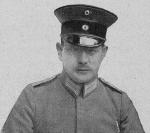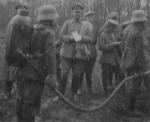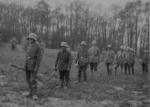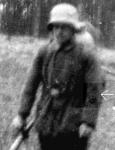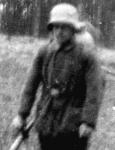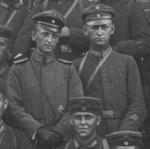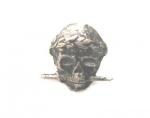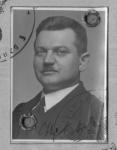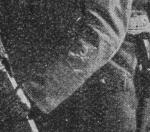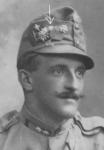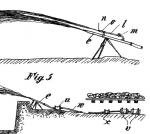
Thomas W
For Deletion-
Posts
788 -
Joined
-
Last visited
-
Days Won
3
Content Type
Profiles
Forums
Blogs
Gallery
Events
Store
Everything posted by Thomas W
-
Whoops! I got it backwards. I went back and looked at Theune, Sturmtruppen und Flammenwerfer, p. 248, and he says that Sturmbataillon Nr. 5 (Rohr) evolved from the Garde-Reserve-Pionier-Regiment. [Aus dem Flammenwerferegiment ging das erste Sturmbataillon Rohr (5. Armee) hervor.] The reason I got it wrong is because this assertion is clearly wrong. The first assault detachment (Sturmabteilung Calsow) was established March 3, 1915. The first flamethrower battalion (III. Garde-Pionier-Bataillon) was established March 15, 1915. Assault Detachment Calsow became Assault Detachment Rohr on September 13, 1915. Assault Detachment Rohr became Assault Battalion Rohr (Sturmbataillon Rohr) on April 1, 1916. The Garde-Reserve-Pionier-Regiment was established April 20, 1916, so Theune was wrong, and I was wrong about Theune. Also, records show that the first of Rohr's flamethrower pioneers came from either the III. Garde-Pionier-Bataillon or Pionier-Ersatz-Bataillon Nr. 36, which provided replacements for the two poison-gas regiments. According to the history of Sturmbataillon Nr. 5 (Rohr,) written by von Schwerin, the detachment's first flamethrower pioneers were unable to function during the detachment's operation of December 1915. There are three possible explanations for this statement: 1. von Schwerin misremembered the action and was wrong; 2. the flamethrower pioneers came from the III. Garde-Pionier-Bataillon but were poorly trained by Reddeman; 3. the flamethrower pioneers came from Pionier-Ersatz-Bataillon Nr. 36 and were poison-gas specialists not trained in the the use of flamethrowers or flame tactics and thus were unable to complete their mission. At any rate, von Schwerin says Rohr had to retrain these flamethrower operators in flame warfare and how to operate with infantry. I don't know what this does to my theory about the black Totenkopf. The photo still shows a single flamethrower carrier wearing what appears to be a very dark Totenkopf in the Rohr position, during an exercise in which the commander of the flamethrower battalion(s), Reddemann, is not wearing any sleeve badge. Reddemann's men NEVER wore a flamethrower badge in the Rohr position. Reddemann himself never mentioned Rohr in any of his writings, so I think he wasn't a fan. As for Theune, he told the Americans after the war that he himself invented the flamethrower and offered to sell them patents for some kind of super-duper flamethrower that was even more effective than the ones the Germans used in the war. Here is what Theune looked like, so maybe we need to take everything he says with a grain of salt.
-
And here's Bernhard Reddemann in the background, the big guy with a notebook and pencil, his overcoat on his shoulder. The flamethrower is the Kleif M.1914. Notice that he doesn't have a Totenkopf sleeve badge. I date this photo to early 1916, probably during the Battle of Verdun. So, according to my theory, the men of the flamethrower platoon of Sturmbataillon Nr. 5 (Rohr) may have begun wearing a black Totenkopf on the sleeve, which Crown Prince Wilhelm saw and then awarded to the flamethrower regiment. By the way, the Austro-Hungarian Strumtruppen began wearing Totenkopf badges after their officers trained at Beuville with Sturmbataillon Rohr and saw the Totenkopf badge worn by the flamethrower pioneers.
-
Another theory about the black Totenkopf: Oberleutnant Ludwig Charles Theune, commander of the 10th Company of the Garde-Reserve-Pionier-Regiment and author of Sturmtruppen und Flammenwerfer, stated after the war that the regiment evolved from Sturmbataillon Nr. 5 (Rohr). First came the assault battalion (March 3, 1915), followed by the flamethrower battalion (March 15, 1915) and then the regiment (April 20, 1916). Theune also said that all the weapons and tactics used by the flamethrower regiment were first developed by the assault battalion. Sturmbataillon Rohr was composed of pioneers, whose color was black. We know that in February of 1918 the men of Sturmbataillon Nr. 5 (Rohr) awarded themselves an unofficial sleeve badge consisting of a crowned white-metal "W" on an oval cloth patch. Is it possible that prior to July 28, 1916, the date that the Totenkopf was officially awarded to the flamethrower regiment, that some of Rohr's flamethrower men were already wearing an unofficial sleeve Totenkopf in black, signifying their service in the pioneer branch? Since Crown Prince Wilhelm took a special interest in Rohr's men, maybe he saw the black badge with red eyes and nose and changed the colors to closer match the Totenkopf he wore as his personal symbol. My theory is based on two undated photos in my collection. They show a Kleif shock troop (Kleifstosstrupp) being demonstrated for Hauptmann Bernhard Reddemann, commander of the 3rd and 4th Guard Pioneer Battalions, in early 1916, I think. If Ludwig Charles Theune is right, these men are probably Rohr's men, showing Reddemann how to use an 11-man Kleif shock troop in action. Reddemann is taking notes, by the way. None of the men wear sleeve Totenkopf--except for one, a flamethrower carrier. His badge is very dark, maybe black. You can see it's on his left arm in the "Rohr" position, above the cuff, and it's an oval badge with a round, skull-shaped device on the cloth. If the badge first originated with Rohr's flamethrower men and was later replaced by a version designed by the Crown Prince, that would explain why nobody's ever heard of it before.
-
More evidence of how regulations weren't strictly followed even in the elite Garde-Reserve-Pionier-Regiment: On the left is Lt. Jünger, commander of Detached Platoon Jünger, and on the right is an Unteroffizier. Lt. Jünger wears an enlisted man's Totenkopf of dark-gray cloth, sewn to the cuff of his Bluse in the position worn by enlisted men. The Unteroffizier, on the other hand, wears an officer's Totenkopf embroidered in silver thread, with no cloth backing, and it's in a weird nonregulation position at the top of his cuff. Very odd.
-
I haven't been able to find out yet. As you know the death's head is often the sign of a specialist unit. Bulgarian flamethrower troops in World War I did not have any official badge or insignia. They were pioneers (pionery) of the First Army Assault Battalion, which was modeled on Sturmbataillon Nr. 5 (Rohr). Flamethrower pioneers may have worn a breast badge in the form of a small metal fire-breathing dragon, but if so it was unofficial. I should say that I've been told that this image is postwar, but it could also be a wartime image.
-
Postwar image of a flamethrower operator of Reichswehr-Brigade 15, who wears a nonofficial Totenkopf in the Sturmbataillon Nr. 5 (Rohr) position above the cuff. He wears a cloth cover on both his helmet and on the Wex flamethrower, and he carries a makeshift stick igniter or fuse (behelfmässigen Stockzünder) consisting of a board with a bundle of kerosene-soaked rags on the end. This was lit with matches and used to ignite large flamethrowers when the automatic igniter burned out.
-
Here's an improved version of the flamethrower used by the Pionier-Versuchskompagnie in the last photo. This is from German Patent No. 256286, filed by Richard Fiedler on July 18, 1909. Both lances (e and l) fired streams of oil, but only the top stream was ignited. It, in turn, ignited the stream from the larger lance. The oil tanks (u) and (x) were placed in a fortified shelter. This model flamethrower was not adopted. This flamethrower was operated by a four-man squad. It had oil reservoirs 1.6m long by 1m in diameter and a hose 20m long. Empty weight was 500kg; full was 1200kg. Fiedler said that a hose up to 200m long could be used without affecting the pressure of the oil stream. Operating pressure was 6-8 atmospheres. The propellant was carbon dioxide produced by liquid carbonic acid in the two propellant bottles. In operation the tripod supporting the lance was fitted with a steel heat shield with viewing slits cut into it. These were covered with clear mica.

